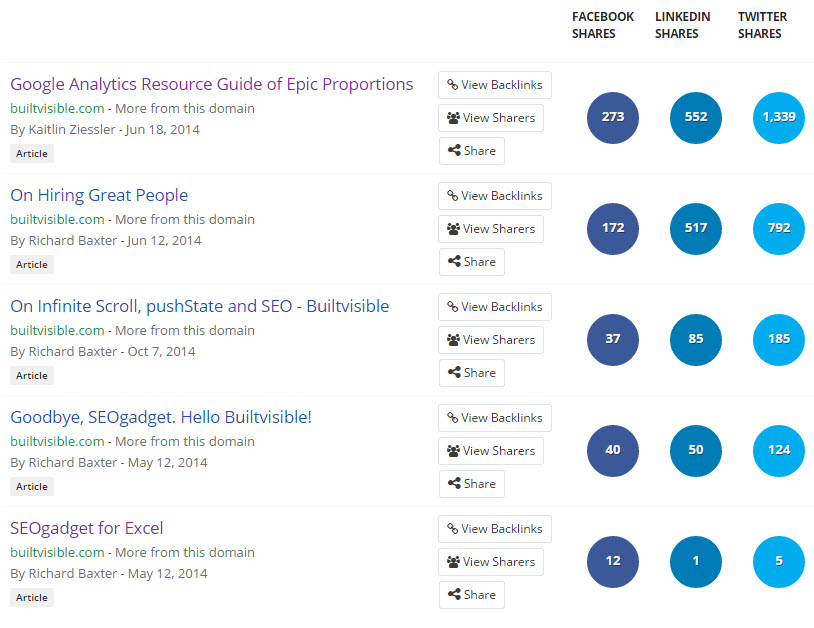Start simple
To be effective in your marketing plan as quickly as possible, it’s important to remember that there are always areas of a website to improve. Rather than reinventing the wheel and trying to come up with a huge new project, what can be updated and re-purposed first?
1. Improve what you have
The blog post Dan wrote on Rich Snippets and Schema.org was already ranking quite well for its target keywords, and, it was attracting links on a reasonably regular basis. As we already had a decent template for in-depth articles from the log file analysis guide, we decided to redevelop the blog post to see if we could tease out more performance from the page. Format, layout and header images were all reworked, and the content itself was given a small, although not fundamental tweak.
We relaunched it and this happened:

Pretty good for a bit of recycled content on a recycled template! Isla featured us in the Moz Best of the Best 2014 roundup. Very cool! Our approach worked well enough for us to do the same with Tom’s beginner’s guide to Google Analytics, which is now one of our most shared pieces of content.
Starting simple works but it needs to start somewhere. I find there are a few highly insightful sources of information worth checking in on, at the start of a new project especially but also on a regular basis.
2. Top performing pages by unique pageviews

Can landing pages that perform well be improved? Can these pages be updated in some way? What about call to action – are you collecting email addresses, encouraging users to follow you for updates and linking to key internal pages?
Don’t forget that your SEO outreach skills might come in really handy here – if these pages are popular, can they be included in any resources or guides belonging to site owners that aren’t currently aware of your brand?
3. Your internal site search

Our internal site search is obviously a reflection of the content our users perceive us to be able to provide. They’re expecting to be able to find whatever they’re looking for. So, are there any search terms that lead to a site exit? Worse, some searches in standard WordPress search end in a 404: “Schema cheat sheet” is a popular search term on our site that ends in a 404! Your content can be improved by making sure it ranks for the right search queries. Using your internal site search data there may be topics you can expand and content you can improve by matching to your users’ expectations.
4. What about your top linked to pages?

Checking which pages are earning links at a reasonable velocity is a smart move. So is checking your main competitors! Have they found something you didn’t? Take a look in the top pages report in aHrefs to find out.
5. Or top performers in Social Media?

Again, what’s been historically popular on your site (and your competitors) can lead to inspiration on what to develop, update and improve. If you’ve got something that’d one well in a particular social network, can you derive a quick win outreach strategy to build a few new links to older content? Use tools like Buzzsumo to find out.
And so many more
“Starting simple” is something I fear is too easy to forget, but getting the first few months of a campaign right (read: effective) can make or break a long term relationship. There are some many ways to start simple, from redeveloping a popular blog post, realigning links to old domains to your new site, finding unlinked brand mentions, making sure your 301 redirects are correctly configured, registering old domains in Webmaster Tools and using Change of Address correctly, performing a gap analysis between your domain and a competitor’s in Searchmetrics, and so on. I suppose as with all things, process plays a huge role at the beginning of a campaign, and so it’s worth deciding what that process is for you and sharing it with the rest of your team.

Caitlin Vandewater
What a great post! As a content writer, I struggle sometimes with trying to find new ways to write for our clients, and for our own company. You’re right–it’s easy to forget that going simple can be the most effective way to both attract a new audience and entice your existing one.
Ben Sibley
It’s cool to hear the way the rich snippets post evolved to become the impressive page it is now. Content like that is a huge investment, and I agree it’s much smarter to start simple and then double-down on what’s working. I have a tendency to try and tackle big new ideas rather than improve what I’ve already got, so reminders like this are always welcome.
Nice work!
Emilia Pineda
Nice piece of work, Richard! Content is king in today’s internet world and I think it is safe to say that we all sometimes struggle coming up with new and interesting content ideas. Keeping a close eye on our competitors, always trying to be the first ones to present a new idea and keep our audience excited, sometimes we forget that we can improve what we already have.